7 Time Management and Organizational Skills Every Marketer Needs to Balance Creativity and Deadlines
Discover seven essential time management and organizational skills to help marketers balance creativity with deadlines and boost productivity.
Marketing is a dynamic field that blends creativity with the pressure of tight deadlines. Whether you're crafting a captivating campaign, brainstorming fresh content ideas, or diving into performance metrics, managing these tasks effectively requires sharp time management and organizational skills. Without them, even the most talented marketers can struggle to keep up, risking rushed work or missed opportunities.
This blog explores seven practical time management strategies and organizational techniques designed specifically for marketers to help balance creative freedom with the demands of deadlines. By mastering these skills, you can boost productivity, enhance your creative output, and deliver consistent results.
Why Time Management and Organizational Skills Are Essential for Marketers
Marketers often juggle multiple roles. One minute, you're ideating a viral social media campaign; the next, you're coordinating with designers, copywriters, or clients to meet a pressing deadline. Poor time management can lead to hurried deliverables, stifled creativity, or burnout, which can impact your reputation and your team's success. Strong organizational skills, paired with effective time management strategies, help you prioritize tasks, allocate resources wisely, and maintain a clear headspace for innovative thinking.
These skills go beyond checking off tasks. They create a structured environment where ideas can thrive without the chaos of last-minute scrambles. Below, we dive into seven essential time management and organizational skills that every marketer should master to excel in their role.
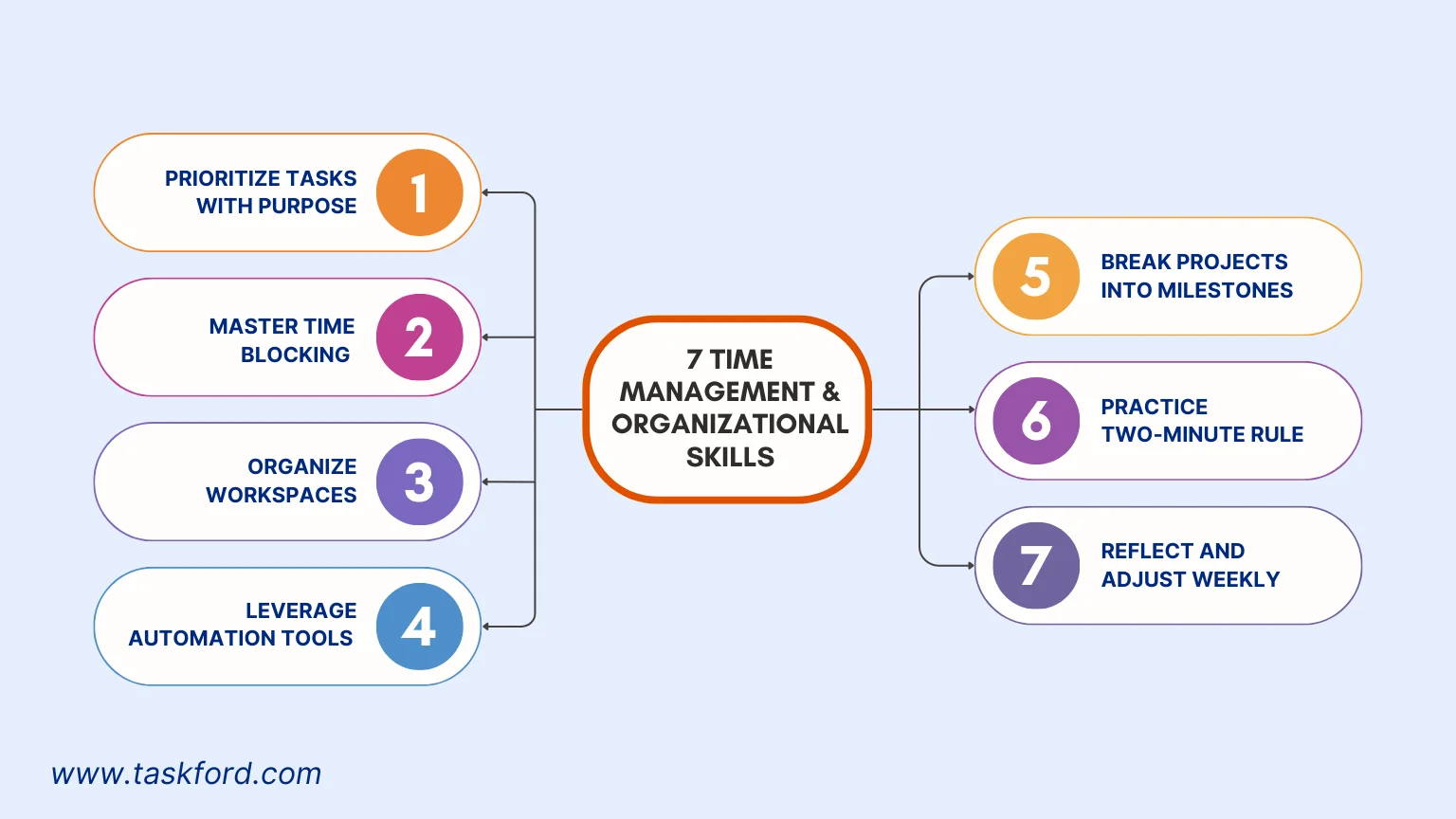
1. Prioritize Tasks with Purpose
Effective time management begins with knowing what matters most. Marketers often face a barrage of tasks, from brainstorming campaign concepts to scheduling social media posts. Without clear priorities, you might spend too much time on low-impact activities, leaving critical projects unfinished.
How to Prioritize Effectively
Use the Eisenhower Matrix to sort tasks by urgency and importance. Divide your to-do list into four categories:
- Urgent and Important: Tackle these immediately (e.g., a client presentation due today).
- Important but Not Urgent: Schedule these for focused work (e.g., developing a long-term content strategy).
- Urgent but Not Important: Delegate these when possible (e.g., responding to non-critical emails).
- Neither Urgent nor Important: Minimize or eliminate these (e.g., excessive social media browsing).
For example, when launching a campaign, focus on crafting the core messaging before tweaking minor design elements. Tools like TaskFord can help you visualize priorities and track deadlines, ensuring you focus on high-impact tasks first.
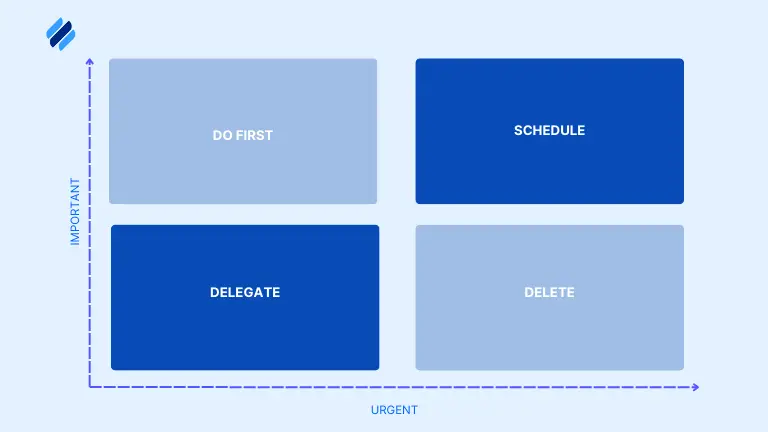
Practical Example
If you're managing a product launch, prioritize creating the campaign’s key visuals over minor edits to an internal document. This keeps your efforts aligned with the project’s goals and deadlines.
2. Master Time Blocking for Creative Focus
Time blocking is a powerful time management strategy that involves scheduling specific periods for particular tasks. A 2020 study published in the Journal of Applied Psychology found that employees using time blocking reported a 15% increase in perceived control over their schedules, enhancing focus and productivity. For marketers, this technique is invaluable because it creates dedicated windows for creative work and administrative duties, preventing them from overlapping.
How to Implement Time Blocking
- Identify Peak Creative Hours: Pinpoint when you're most creative (e.g., morning or late afternoon) and reserve those times for brainstorming or content creation.
- Schedule Deep Work: Set aside uninterrupted blocks for tasks requiring focus, like writing ad copy or designing visuals.
- Batch Similar Tasks: Group related tasks, such as responding to emails or scheduling posts, to reduce context-switching.
- Use Tools: Google Calendar or apps like Clockify can help you allocate time slots and stick to them.
For instance, block 9 AM to 11 AM for creative brainstorming and 2 PM to 3 PM for meetings. This protects your creative energy while ensuring you meet deadlines.
Pro Tip: Include buffer time between blocks to handle unexpected tasks or give your brain a break. This keeps you refreshed and ready for the next task, boosting overall productivity.
3. Organize Digital and Physical Workspaces
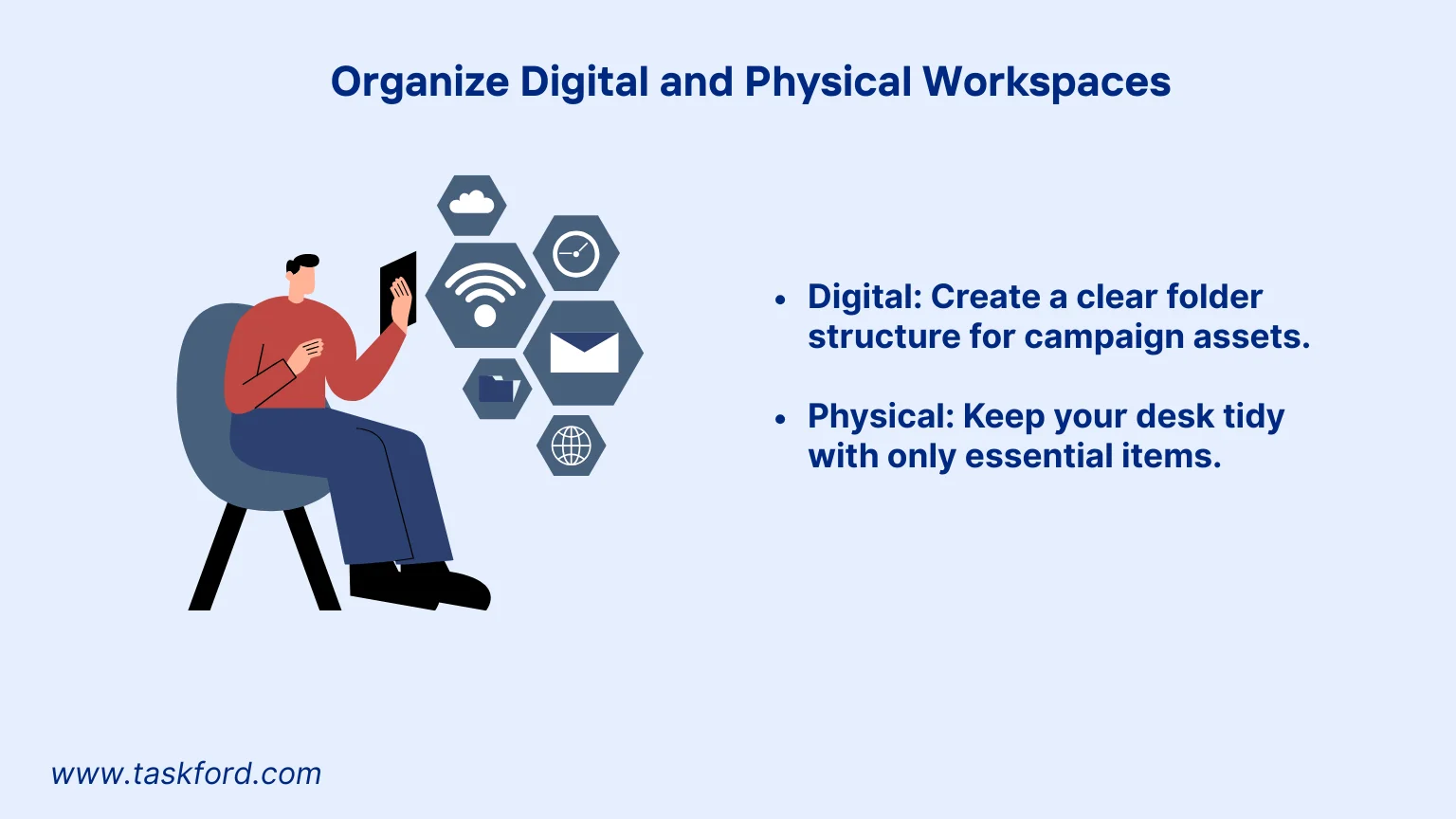
A cluttered workspace, whether digital or physical, can derail your time management efforts. Disorganized files, overflowing inboxes, or a messy desk can waste time and increase stress, pulling you away from creative tasks.
Steps to Stay Organized
- Digital Organization: Create a clear folder structure for campaign assets. For example, organize files by project (e.g., "Q4 Campaign" > "Social Media" > "Graphics"). Use cloud storage like Google Drive or Dropbox for easy access.
- Email Management: Set up filters to sort emails into folders (e.g., "Client Communication," "Team Updates"). Aim to clear your inbox daily by archiving or deleting irrelevant emails.
- Physical Workspace: Keep your desk tidy with only essential items. A clean space reduces distractions and helps you focus on tasks like sketching campaign ideas or reviewing analytics.
Real-World Example
A marketer working on a multi-channel campaign might create a folder structure like "2025 Product Launch" with subfolders for "Email," "Social," and "Analytics." This setup saves time when retrieving assets under tight deadlines.
Why It Works
An organized workspace reduces stress and supports better time management, allowing you to focus on high-priority marketing tasks.
4. Leverage Automation Tools to Save Time
Automation is a marketer’s secret weapon for managing time effectively. By automating repetitive tasks, you free up hours for creative work and strategic planning.
Automation Tools to Consider
- Social Media Scheduling: Tools like Hootsuite or Buffer allow you to schedule posts across platforms in advance, ensuring consistent content delivery without daily manual effort.
- Email Marketing: Platforms like Mailchimp or HubSpot automate email campaigns, from drip sequences to follow-ups, saving hours of manual work.
- Analytics Reporting: Use tools like Google Analytics or Supermetrics to generate automated reports, so you can focus on interpreting data rather than compiling it. Moreover, TaskFord, a comprehensive project management and resource planning platform, also has reporting ability to analyze the time and workloads used by employees in order to assign tasks in a more suitable way.

Practical Application
If you manage social media for a brand, schedule a week’s worth of posts in one sitting using a scheduling tool. This frees up time to craft engaging content or analyze performance metrics.
Why It Works
Automation saves time on repetitive tasks, allowing marketers to focus on high-value activities like strategy development and creative ideation.
5. Break Projects into Manageable Milestones
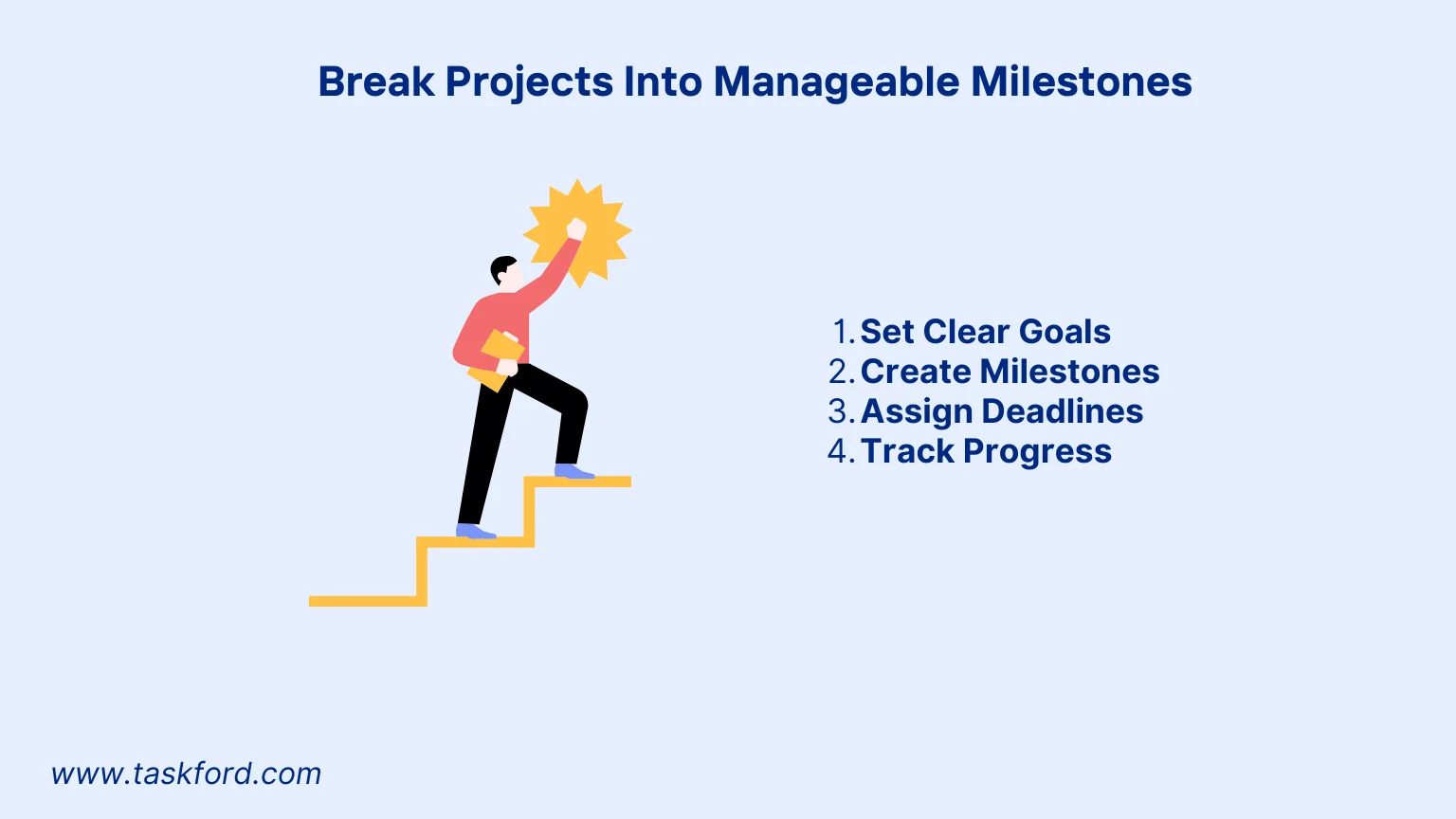
Large marketing projects, like launching a new campaign or rebranding, can feel daunting. Breaking them into smaller milestones makes them more manageable and keeps you on track.
How to Break Down Projects
- Set Clear Goals: Define the project’s end goal (e.g., "Increase email open rates by 20%").
- Create Milestones: Divide the project into phases, such as "Research," "Content Creation," and "Launch."
- Assign Deadlines: Set realistic deadlines for each milestone to maintain momentum.
- Track Progress: Use project management tools like TaskFord or Monday.com to monitor progress and adjust as needed.
For example, if you're developing a content calendar, break it into stages: research trending topics, draft content, design visuals, and schedule posts. This approach prevents procrastination and ensures steady progress.
Why It Works
Milestones provide a clear roadmap, reducing the risk of missing deadlines and allowing you to celebrate small wins, which boosts motivation.
6. Practice the Two-Minute Rule for Quick Wins
The two-minute rule is a simple time management strategy: if a task takes less than two minutes, do it immediately. For marketers, this prevents small tasks from piling up and disrupting your schedule.
Examples of Two-Minute Tasks
- Replying to a quick client email.
- Approving a minor design change.
- Posting a quick social media update.
By tackling these tasks right away, you keep your to-do list manageable and avoid the mental clutter of unfinished micro-tasks.
When to Be Cautious
Don’t let the two-minute rule interrupt focused creative time. If you’re writing a blog post, save quick tasks for a designated break or batch them during a low-energy period.
Why It Works
Clearing small tasks quickly keeps your schedule manageable, leaving more time for strategic marketing efforts.
7. Reflect and Adjust Weekly
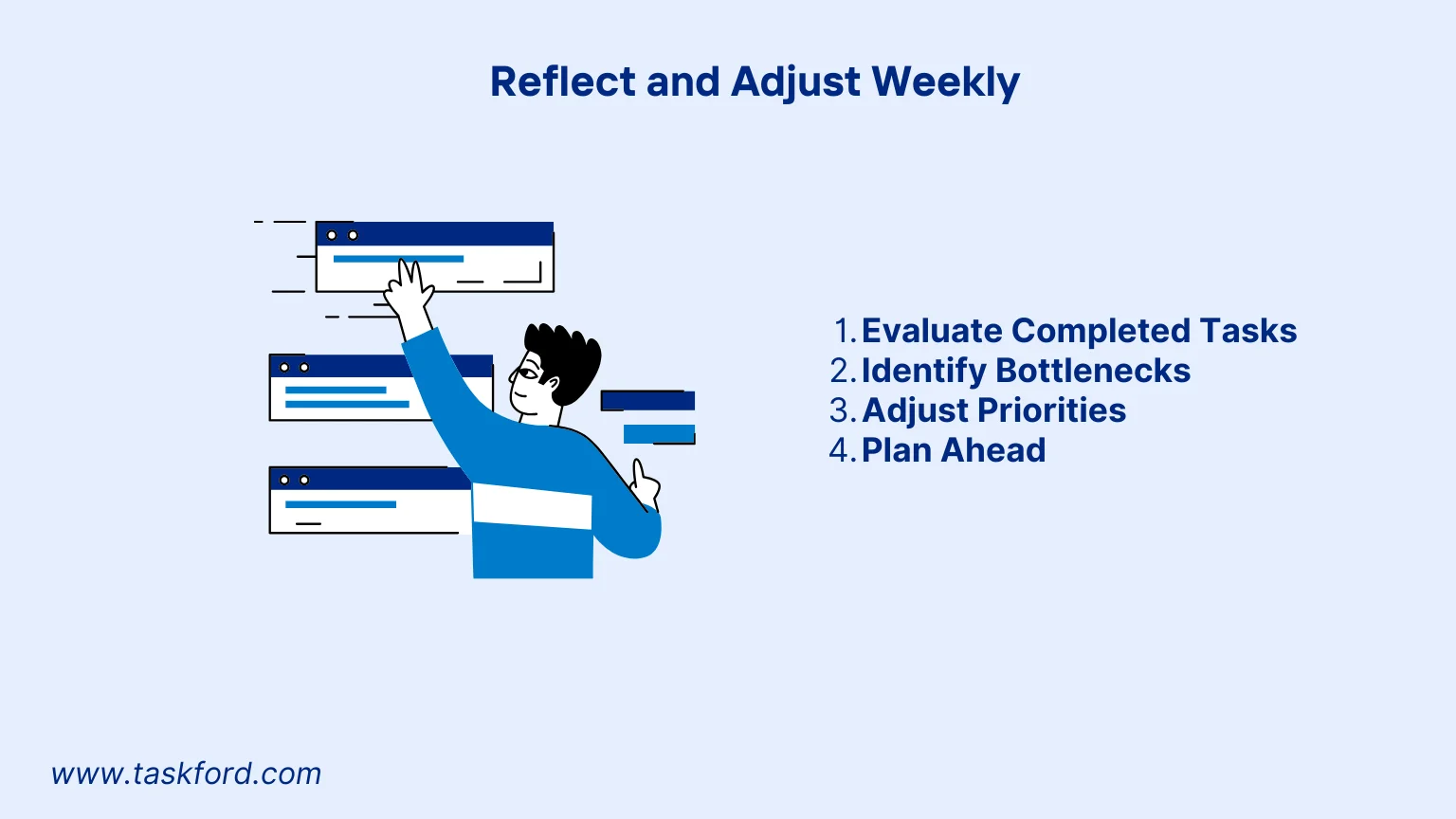
Time management and organizational skills require regular fine-tuning. A weekly review helps you assess what’s working, identify bottlenecks, and plan for improvement.
How to Conduct a Weekly Review
- Evaluate Completed Tasks: Review what you accomplished and whether you met deadlines.
- Identify Bottlenecks: Pinpoint tasks that took longer than expected or caused stress.
- Adjust Priorities: Reassess your priorities for the upcoming week based on campaign needs or new deadlines.
- Plan Ahead: Set goals and time blocks for the next week to stay proactive.
For instance, if you spent too much time in meetings last week, adjust by scheduling fewer or shorter ones. Use insights from tools like Google Analytics to guide your priorities, such as focusing on underperforming campaigns.
Why It’s Essential
Regular reflection ensures your time management strategies evolve with your workload, keeping you agile and effective in a dynamic marketing environment.
Emerging Trends in Time Management for Marketers
As marketing evolves with technology and changing consumer behaviors, so do the tools and strategies for managing time effectively. Staying ahead of these trends can give marketers a competitive edge in balancing creativity and deadlines.
Key Trends to Watch
- AI-Powered Task Management: Artificial intelligence is transforming how marketers manage tasks. AI tools can analyze workloads, suggest task prioritizations, and predict project timelines based on past performance. These tools help marketers focus on high-value creative tasks by automating routine planning.
- Hybrid Work Optimization: With hybrid work models becoming standard, marketers are adopting tools like TaskFord to centralize project plans and enable real-time collaboration across remote and in-office teams. This ensures alignment and reduces time lost to miscommunication.
- Focus on Micro-Productivity: Micro-productivity, or breaking tasks into ultra-short intervals (e.g., 10-minute sprints), is gaining traction. This approach, inspired by the Pomodoro Technique, helps marketers maintain focus during high-pressure campaigns by alternating short bursts of work with brief breaks.
- Data-Driven Time Allocation: Marketers are increasingly using data to inform time management decisions, to see which tasks (e.g., email optimization vs. social media posting) drive the most ROI, allowing you to allocate time to high-impact activities.
Conclusion
Mastering time management and organizational skills empowers marketers to balance creativity with deadlines. By prioritizing tasks, time blocking, organizing workspaces, leveraging automation, breaking down projects, applying the two-minute rule, and reflecting weekly, you can boost productivity and keep your creative edge. Start with one or two of these strategies and build from there to transform how you tackle marketing challenges, ensuring you deliver standout campaigns every time.
Learn more
- The Role Of A Marketing Project Manager : Responsibilities, Skills, and Real Impact
- How To Set Priority in Your Marketing Strategy and Avoid Random Acts of Marketing
- How Marketing Project Management Tools Keep Everything on Track
Making work simpler,
smarter, and more connected
Join our waitlist and be notified first.

Related Blog
Subscribe for Expert Tips
Unlock expert insights and stay ahead with TaskFord. Sign up now to receive valuable tips, strategies, and updates directly in your inbox.




